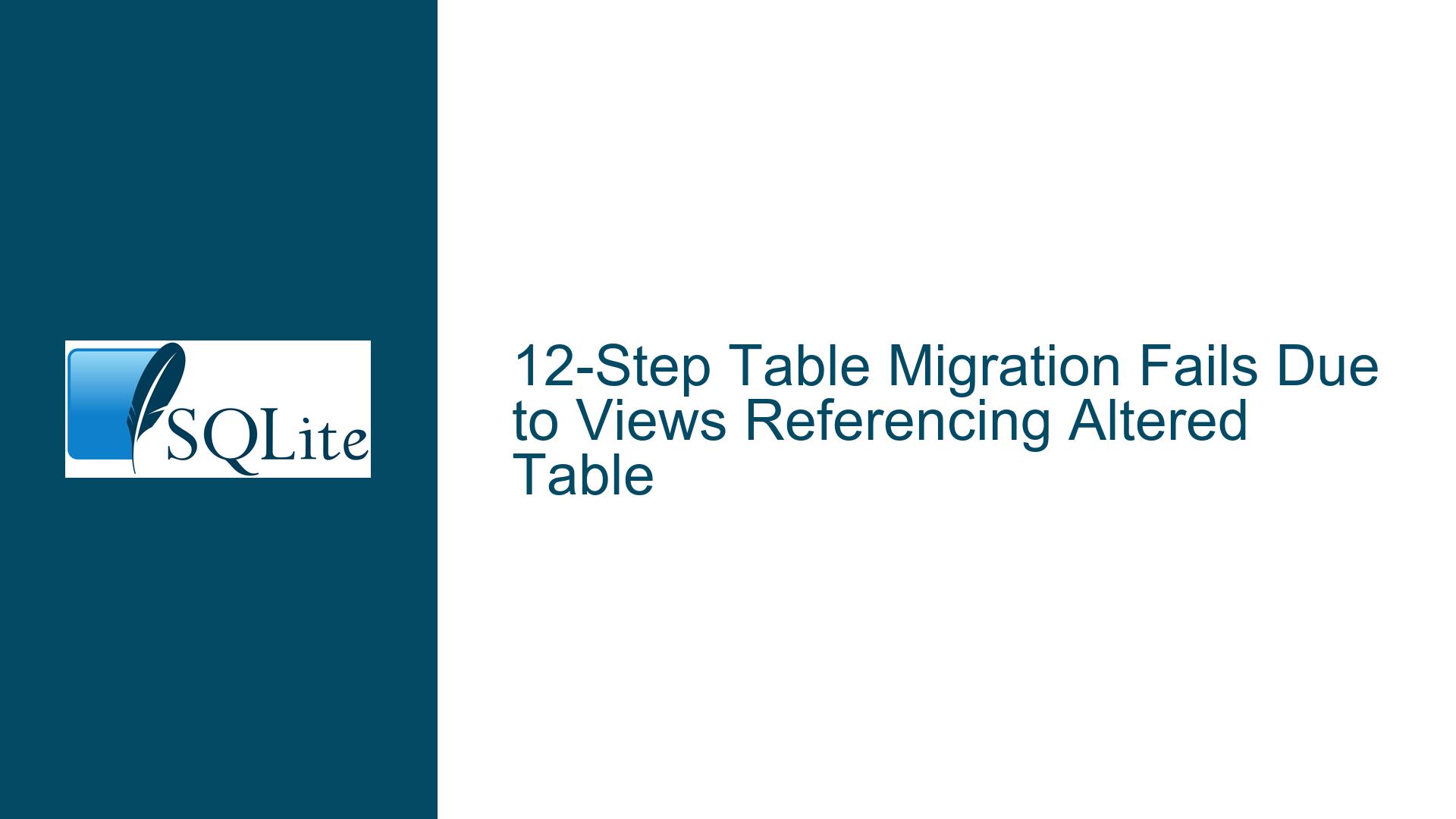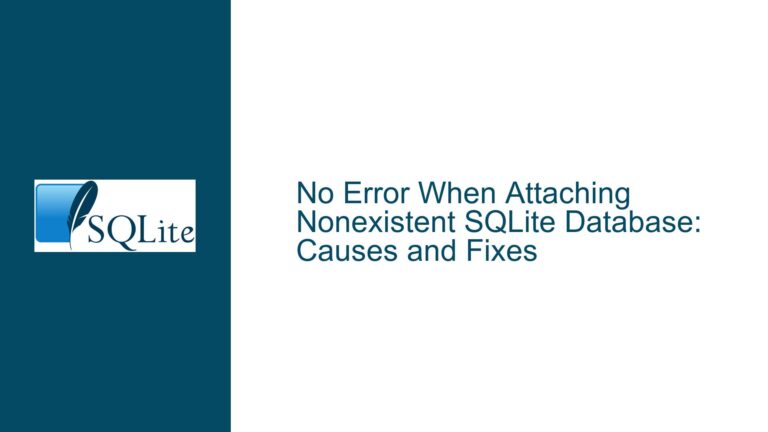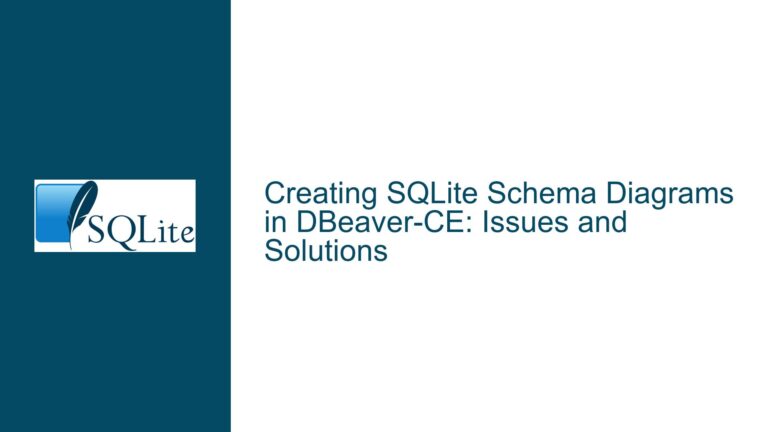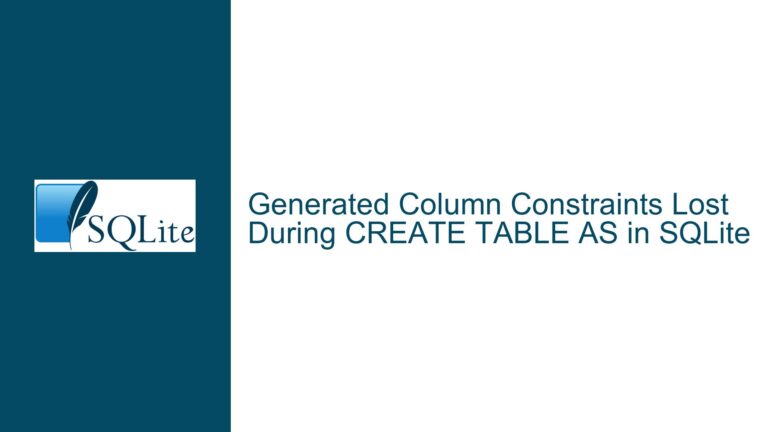12-Step Table Migration Fails Due to Views Referencing Altered Table
Schema Migration Failure During Table Rename with Dependent Views
The 12-step table migration procedure in SQLite is designed to safely alter a table’s schema while preserving data integrity. However, when views reference the original table, the migration fails at the ALTER TABLE ... RENAME step with an error such as:
Runtime error: error in view user_names: no such table: main.users.
This occurs because SQLite enforces schema consistency checks during schema-altering operations. When the original table (users) is dropped, any views dependent on it (user_names) are left referencing a nonexistent table. The subsequent attempt to rename the replacement table (new_users to users) triggers a validation error. The core issue arises from the inconsistent schema state caused by the orphaned view.
The problem is specific to views because SQLite does not automatically drop or invalidate views when their underlying tables are removed. Unlike indexes or triggers, which are tied directly to the table and are automatically dropped, views are stored as parsed SQL text and retain their dependency links. The schema validation process detects this inconsistency and prevents the ALTER TABLE operation from completing.
Key symptoms include:
- Failure at step 7 (
ALTER TABLE new_users RENAME TO users) with a "no such table" error. - Inability to proceed with the migration until dependent views are addressed.
- No issues with indexes or triggers referencing the original table, as these are automatically dropped when the table is removed.
Schema Validation Mechanics and View Dependency Tracking
1. SQLite’s Schema Consistency Enforcement
SQLite performs rigorous schema validation during ALTER TABLE operations. The database engine ensures that both the starting and ending states of the schema are valid. When the original table (users) is dropped, the schema becomes invalid because the view user_names references a nonexistent table. The ALTER TABLE command aborts to prevent further inconsistencies.
2. View Dependency Management
Views are stored in the sqlite_schema table as raw SQL text. Unlike indexes or triggers, which are compiled into bytecode and linked directly to their parent tables, views are re-parsed and validated at runtime. This design allows views to reference multiple tables or other views but creates a problem during schema migrations: SQLite cannot automatically determine whether a view should be dropped when its underlying table is removed.
3. Legacy vs. Modern ALTER TABLE Behavior
The legacy_alter_table pragma disables schema consistency checks, mimicking pre-SQLite 3.25 behavior (prior to the introduction of ALTER TABLE enhancements). Enabling this pragma allows the rename operation to proceed despite the invalid schema. However, this workaround is discouraged because it bypasses safeguards designed to prevent data corruption.
4. Documentation Ambiguity
The 12-step migration guide instructs users to "remember the format of all indexes, triggers, and views associated with table X" but does not explicitly state that views must be manually dropped and recreated. This omission can lead to confusion, as users may assume that views are handled similarly to indexes or triggers.
Resolving Migration Errors by Addressing View Dependencies
1. Manual View Management During Migration
The safest approach is to explicitly drop and recreate views during the migration process:
Before starting the migration: Identify all views dependent on the table.
SELECT name, sql FROM sqlite_schema WHERE type = 'view' AND sql LIKE '%users%';This query searches the
sqlcolumn of views for references tousers.Modify the migration steps:
- Step 3 (Documentation): Record the SQL of dependent views (e.g.,
user_names). - Step 6 (Drop original table): Drop the views before dropping the original table:
DROP VIEW IF EXISTS user_names; DROP TABLE users; - Step 11 (Recreate objects): Recreate the views after renaming the new table:
CREATE VIEW user_names AS SELECT name FROM users;
- Step 3 (Documentation): Record the SQL of dependent views (e.g.,
Example Workflow:
BEGIN;
CREATE TABLE new_users (id INTEGER PRIMARY KEY, name TEXT DEFAULT 'no name set');
INSERT INTO new_users SELECT * FROM users;
DROP VIEW user_names; -- Manually drop dependent view
DROP TABLE users;
ALTER TABLE new_users RENAME TO users;
CREATE VIEW user_names AS SELECT name FROM users; -- Recreate view
COMMIT;
2. Using legacy_alter_table Pragmatically
If manual view management is impractical, temporarily enable legacy_alter_table:
PRAGMA legacy_alter_table = ON; -- Disable schema validation
BEGIN;
CREATE TABLE new_users (...);
INSERT INTO new_users SELECT * FROM users;
DROP TABLE users;
ALTER TABLE new_users RENAME TO users;
COMMIT;
PRAGMA legacy_alter_table = OFF; -- Re-enable validation
Risks:
- Bypassing schema validation can lead to undetected corruption if other schema inconsistencies exist.
- This approach is not recommended for automated or production systems.
3. Automated Dependency Detection
For complex schemas, automate view dependency tracking by parsing the sqlite_schema table:
-- Retrieve views dependent on 'users'
SELECT name AS view_name, sql AS view_definition
FROM sqlite_schema
WHERE type = 'view'
AND (
sql LIKE '% users %' -- Space-delimited match
OR sql LIKE '% users%' -- Match at end of line
OR sql LIKE '%users %' -- Match at start of line
OR sql LIKE '%(users)%' -- Parentheses (common in JOINs)
);
Limitations:
- This method may produce false positives (e.g., views referencing a column named
users). - Use a SQL parser for precise dependency resolution in critical environments.
4. Schema Migration with Writable Schema
Advanced users can temporarily enable writable schema to modify internal metadata:
PRAGMA writable_schema = ON;
-- Update view definitions in sqlite_schema
UPDATE sqlite_schema
SET sql = replace(sql, 'FROM users', 'FROM new_users')
WHERE name = 'user_names';
PRAGMA writable_schema = OFF;
Caveats:
- Directly modifying
sqlite_schemais risky and can corrupt the database. - Always backup the database before attempting this method.
5. Preventing Future Issues
- Documentation Adherence: Explicitly drop and recreate views during migrations, even if not mentioned in the 12-step guide.
- Testing: Validate migrations in a staging environment using tools like
sqlite3_test_controlto simulate schema changes. - Dependency Tracking: Maintain a registry of views and their dependencies outside SQLite (e.g., in version control).
Comparative Analysis with Other Databases
- PostgreSQL: Supports
DROP TABLE ... CASCADEto automatically drop dependent views. SQLite avoids this to prevent accidental data loss. - MySQL: Requires manual view management but provides
INFORMATION_SCHEMA.VIEWSfor dependency tracking. - SQLite Philosophy: Prioritizes simplicity and explicitness, requiring users to manage dependencies manually.
Conclusion
The migration failure stems from SQLite’s strict schema validation and the lack of automatic view dependency resolution. By manually managing views, leveraging pragmas cautiously, or employing advanced schema modifications, users can successfully complete the 12-step migration. Future improvements to SQLite’s ALTER TABLE command or dependency tracking mechanisms could streamline this process, but until then, meticulous schema management remains essential.






